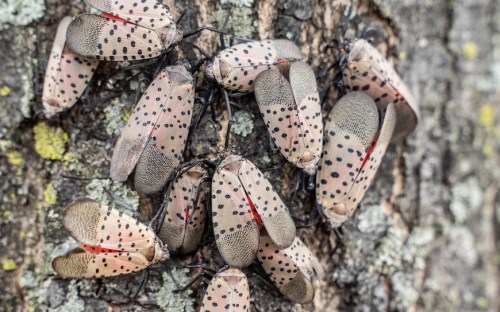With its ruby red body and polka dot wings, the spotted lanternfly is objectively beautiful. Despite its good looks, state and federal officials are spreading a the same message for managing the invasive species: If you spot a spotted lanternfly, squish it on sight.
Experts in This Article
staff entomologist and research scientist for the National Pest Management Association (NPMA)
Left to its own devices, the spotted lanternfly threatens the ecological integrity of the Midwestern and Western parts of the United States. “Spotted lanternflies are a threat to our city’s forests,” the New York City’s Parks Department tweeted. “If you see a spotted lanternfly, squish it, dispose of it, and report it to us.”
A flurry of warnings came in 2021 after an 11-year-old boy unknowingly showcased a spotted lanternfly as part of his insect collection at the Kansas State Fair. While judging the contest, one of the officials recognized the insect as Lycorma delicatula, an invasive species farmers in the eastern United States have been battling for years. How the spotted lanternfly made its way to Kansas has left state and federal officials worried and scratching their heads. The discovery of a spotted lanternfly in Kansas signals the invasive species is traveling west.

Brittany Campbell, PhD, an entomologist and research scientist for the National Pest Management Association, says although they won’t bite or sting humans, spotted lanternflies are particularly dangerous to agricultural communities. Native to China, the first one appeared in Pennsylvania in 2014, before spreading up and down the East Coast and as far west as Indiana. Their appetite for fresh produce is only matched by their ability to destroy forests.
“They pose significant threats to woody and non-woody plants,” she says. “They’re also capable of causing harm to grape, fruit tree, and logging industries, as they feed on the sap within many trees and plants.”
As their name would suggest, spotted lanternflies can in fact fly, but it’s more likely the winged insect hitchhiked its way to Kansas on a vehicle transporting crops. Although state and federal officials are investigating an ongoing potential infestation, the Washington Post reported that the boy submitted a “worn and desiccated” dead specimen he had found in May, which could have been dead for over a year.
Still, the warnings are clear: If you see a spotted lanternfly, kill it (and photograph it and put it in a jar of rubbing alcohol if possible). The invasive pest is nothing more than a threat to our ecosystem.
“The spread of spotted lanternflies will be limited in some states based on climate,” says Campbell. “Models have shown that the spotted lanternfly could become established throughout several central and midwestern states that do not get too hot or too cold for this pest to thrive.”
In addition to killing the bugs, Campbell suggests alerting professionals who can help mitigate risks accordingly. “Be sure to regularly check cars and any outdoor equipment [for insects], like grills, firewood, trees, outdoor furniture and lawnmowers,” she says. “If you find egg masses around your home, scrape them off and place them in a double bag before disposing of them in the trash. You should also contact your local Department of Agriculture to report a sighting and any migration of this invasive species.”
Sign Up for Our Daily Newsletter
Get all the latest in wellness, trends, food, fitness, beauty, and more delivered right to your inbox.
Got it, you've been added to our email list.











